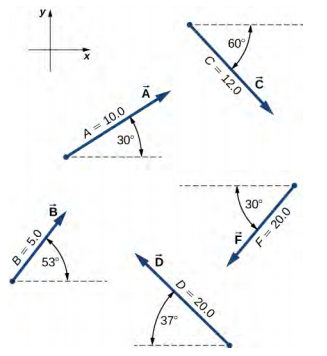18.2: Vetores
- Page ID
- 184967
Verifique sua compreensão
2.1. a. Não são iguais porque são ortogonais; b. não são iguais porque têm magnitudes diferentes; c. não são iguais porque têm magnitudes e direções diferentes; d. não são iguais porque são antiparalelas; e. iguais.
2.2. 16 m;\(\vec{D}\) = −16 m\(\hat{u}\)
2.3. G = 28,2 cm,\(\theta_{G}\) = 291°
2.4. \(\vec{D}\)= (−5,0\(\hat{i}\) − 3,0\(\hat{j}\)) cm; a mosca se moveu 5,0 cm para a esquerda e 3,0 cm para baixo do local de pouso.
2,5. 5,83 cm, 211°
2.6. \(\vec{D}\)= (−20 m)\(\hat{j}\)
2.7. 35,1 m/s = 126,4 km/h
2.8. \(\vec{G}\)= (10,25\(\hat{i}\) − 26,22\(\hat{j}\)) cm
2,9. D = 55,7 N; direção 65,7° norte de leste
2,10. \(\hat{v}\)= 0,8\(\hat{i}\) + 0,6\(\hat{j}\), 36,87° norte do leste
2.11. \(\vec{A} \cdotp \vec{B}\)= −57,3,\(\vec{F} \cdotp \vec{C}\) = 27,8
2.13. 131,9°
2,14. W 1 = 1,5 J, W 2 = 0,3 J
2,15. \(\vec{A} \times \vec{B}\)= −40,1\(\hat{k}\) ou, equivalentemente, |\(\vec{A} \times \vec{B}\) | = 40,1, e a direção está na página;\(\vec{C} \times \vec{F}\) = + 157,6\(\hat{k}\) ou, equivalentemente, |\(\vec{C} \times \vec{F}\) | = 157,6, e a direção está fora da página.
2,16. a. −2\(\hat{k}\), b. 2, c. 153,4°, d. 135°
Perguntas conceituais
1. Escalar
3. As respostas podem variar
5. Paralelo, soma das magnitudes, antiparalelo, zero
7. Sim, sim
9. Zero, sim
11. Não
13. Igual, igual, o mesmo
15. Um vetor unitário do eixo x
17. Eles são iguais.
19. Sim
21. a. C =\(\vec{A} \cdotp \vec{B}\), b.\(\vec{C} = \vec{A} \times \vec{B}\) ou\(\vec{C} = \vec{A} - \vec{B}\), c.\(\vec{C} = \vec{A} \times\vec{B}\), d.\(\vec{C}\) = A\(\vec{B}\), e., f.\(\vec{C} + 2 \vec{A} = \vec{B}\)\(\vec{C} = \vec{A} \times \vec{B}\), g. o lado esquerdo é um escalar e o lado direito é um vetor\(\vec{C} = 2 \vec{A} \times \vec{B}\), h., i.\(\vec{C} = \frac{\vec{A}}{B}\), j.\(\vec{C} = \frac{\vec{A}}{B}\)
23. Eles são ortogonais.
Problemas
25. \(\vec{h}\)= −16,4 m\(\hat{u}\), 16,4 m
27. 30,8 km, 35.7° a oeste do norte
29. 134 km, 80°
31. 7.34 km, 63.5° ao sul de leste
33. 3,8 km a leste, 3,2 km ao norte, 7,0 km
35. 14.3 km, 65°
37. a.\(\vec{A}\) = + 8,66\(\hat{i}\) + 5,00\(\hat{j}\)
b.\(\vec{B}\) = + 3,01\(\hat{i}\) + 3,99\(\hat{j}\)
c.\(\vec{C}\) = + 6,00\(\hat{i}\) − 10,39\(\hat{j}\)
d.\(\vec{D}\) = −15,97\(\hat{i}\) + 12,04\(\hat{j}\)
f.\(\vec{F}\) = −17,32\(\hat{i}\) − 10,00\(\hat{j}\)

39. a. 1,94 km, 7,24 km
b. prova
41. 3,8 km a leste, 3,2 km ao norte, 2,0 km,\(\vec{D}\) = (3,8\(\hat{i}\) + 3,2\(\hat{j}\)) km
43. P 1 (2.165 m, 1.250 m), P 2 (−1.900 m, 3.290 m), 5,27 m
45. 8,60 m, A (2\(\sqrt{5}\) m, 0,647\(\pi\)), B (3\(\sqrt{2}\) m, 0,75\(\pi\))
47. a.\(\vec{A} + \vec{B}\) = −4\(\hat{i}\) − 6\(\hat{j}\), |\(\vec{A} + \vec{B}\) | = 7,211,\(\theta\) = 236,3°
b.\(\vec{A} -\vec{B}\) = -2\(\hat{i}\) + 2\(\hat{j}\), |\(\vec{A} - \vec{B}\) | = 2\(\sqrt{2}\),\(\theta\) = 135°
49. a.\(\vec{C}\) = (5,0\(\hat{i}\) − 1,0\(\hat{j}\) − 3,0\(\hat{k}\)) m, C = 5,92 m
b.\(\vec{D}\) = (4,0\(\hat{i}\) − 11,0\(\hat{j}\) + 15,0\(\hat{k}\)) m, D = 19,03 m
51. \(\vec{D}\)= (3,3\(\hat{i}\) − 6,6\(\hat{j}\)) km,\(\hat{i}\) está a leste, 7,34 km, −63,5°
53. a.\(\vec{R}\) = −1,35\(\hat{i}\) − 22,04\(\hat{j}\)
b.\(\vec{R}\) = −17,98\(\hat{i}\) + 0,89\(\hat{j}\)
55. \(\vec{D}\)= (200\(\hat{i}\) + 300\(\hat{j}\)) yd, D = 360,5 yd, 56,3° norte do leste; As respostas numéricas permaneceriam as mesmas, mas a unidade física seria metros. O significado físico e as distâncias seriam aproximadamente os mesmos porque 1 jarda é comparável a 1 m.
57. \(\vec{R}\)= −3\(\hat{i}\) − 16\(\hat{j}\)
59. \(\vec{E}\)= E\(\hat{E}\), E x = + 178,9 V/m, E y = −357,8 V/m, E z = 0,0 V/m,\(\theta_{E}\) = −tan −1 (2)
61. a.\(\vec{R}_{B}\) = (12,278\(\hat{i}\) + 7,089\(\hat{j}\) + 2.500\(\hat{k}\)) km,\(\vec{R}_{D}\) = (−0,262\(\hat{i}\) + 3.000\(\hat{k}\)) km
b. |\(\vec{R}_{B} − \vec{R}_{D}\) | = 14.414 km
63. uma. 8.66
b. 10.39
c. 0,866
d. 17,32
65. \(\theta_{i}\)= 64,12°,\(\theta_{j}\) = 150,79°,\(\theta_{k}\) = 77,39°
67. a. −119,98\(\hat{k}\)
b. 0\(\hat{k}\)
c. +93,69\(\hat{k}\)
d. −240,0\(\hat{k}\)
p. +3.993\(\hat{k}\)
f. −3,009\(\hat{k}\)
g. +14,99\(\hat{k}\)
h. 0
69. uma. 0
b. 173.194
c. +199.993\(\hat{k}\)
Problemas adicionais
71. a. 18,4 km e 26,2 km
b. 31,5 km e 5,56 km
73. a. (r,\(\phi + \frac{\pi}{2}\))
b. (2r,\(\phi + 2 \pi\))
c. (3r, −\(\phi\))
75. d PM = 33,12 mi = 61,34 km, d PN = 35,47 mi = 65,69 km
77. prova
79. a. 10,00 m
b. 5\(\pi\) mm, c. 0
81. 22,2 km/h, 35,8° ao sul de oeste
83. 240,2 m, 2.2° ao sul de oeste
85. \(\vec{B}\)= −4,0\(\hat{i}\) + 3,0\(\hat{j}\) ou\(\vec{B}\) = 4,0\(\hat{i}\) − 3,0\(\hat{j}\)
87. prova
Problemas de desafio
89. G \(\perp\)= 2375\(\sqrt{17}\) ≈ 9792
91. prova


